
30+ B2B Lead Generation Strategies That Deliver Marketing ROI
Everyone receives marketing emails, and we get bombarded with advertising constantly. It’s getting increasingly difficult to cut through the noise, so the demand for innovative new tactics is at an all time high.
When we say new tactics, we’re not talking about re-inventing your current strategies or developing new lead generation channels per se. We mean other things you can do to complement your current efforts and give them a much-needed boost.
Driven by a host of emerging technologies and an influx of new insights, B2B buyer behavior continues to evolve at breakneck speeds. Understandably, B2B marketers are hard-pressed to recalibrate their lead generation strategies in this ever-shifting landscape.
Many businesses spend a great deal of time and resources on lead generation. This is completely understandable since, without a consistent influx of new leads, a business simply can’t grow. So marketers go out and invest in proven tactics that drive prospects towards your brand’s sales funnel:
- Email Marketing – It’s got the best ROI in the business
- SEO – We all want to be on the first page of Google
- Content Marketing – Everyone’s got a success story they can tell with content
- Social Media Marketing – There are over 4 billion active social media users globally
That’s all good and well. After all, we’re all about the pillars of lead generation. But, sometimes, we have to remind ourselves to think outside the box.
The explosion of content addressing consumer concerns at every step of the buyer’s journey has developed increasingly educated consumers. Additionally, advancing technology has heightened consumer expectations for customer experience.
In fact, a study by Walker Information, projected that customer experience has surpassed price and product as the key brand differentiator.
Some B2B brands are getting better at converting their prospects while others are stuck in their old ways, perhaps unsure how to spice things up.
But 61% percent of businesses say that lead generation is their biggest marketing challenge.
There are many free lead capturing tactics out there, but few will help you maximize your ROI. Here are effective B2B lead generation strategies that will play up your game.
1. Create High-Quality, Evergreen Content
Content is the currency of the web nowadays, so you should regularly publish content. This not only helps your credibility as an expert, but it also increases your reach and exposure. But don’t create content for content’s sake. You want your content to provide value to your audience, not just sit there and make your brand look pretty.
When you publish valuable content that informs, educates, and entertains your target audience, you earn their loyalty. It’s easier to convert leads once you’ve gained their trust.
Also important is the frequency of your publishing. Publishing quality blog posts more often shows your target audience your commitment to go to great lengths to provide them with valuable content that addresses their concerns.
According to a study by Hubspot, companies that publish 16 or more blog posts per month generate 4.5 times more leads than those who publish only 0-4 posts per month. The study further revealed that 47% of B2B buyers rely on content for research and making purchasing decisions.

More significantly, B2B buyers consume at least three to five pieces of related content before contacting a sales person. Leverage this information by producing more content more frequently so you can cater to your audience’s information demands.
Lastly, while moment marketing is a great way to stay relevant or go viral for a certain duration, coming up with evergreen topics in your niche is a sure way to get noticed no matter what stage your potential clients are in the sales funnel.
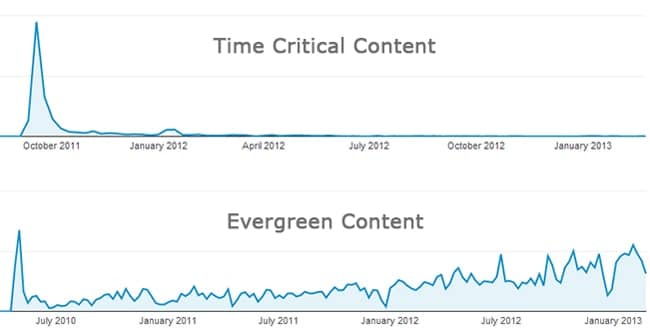
Evergreen content works hand in hand with your SEO strategy, allowing you to stay fresh on search engines. Evergreen content is helpful, informative, and shareable—all the things people love about high-quality content. Plus, it never goes out of style.
PS – Check out our weekly blog content service to grow your website traffic and leads!
2. Gate Your Content Strategically
Not every marketer is confident whether or not they should gate their content. However, this is still one of the most effective ways to attract and identify leads who care about your business.
When done right, gated content can increase leads and conversions. Case in point: Finance and trade website Trading Strategy Guides added almost 11,000 targeted subscribers to their email list in just one month by using a content locking script. Unbounce’s gated content stats reveal more campaigns with conversion rates that fall between 19-45%.
Putting out gated content is wise if you’ve already built a library of content that you are sure your audience is enjoying. This way, loyal readers won’t be apprehensive in giving you their names and email addresses to read what you wrote.
3. Syndicate Your Content
Content syndication amplifies your brand’s content by leveraging the audiences of complementary brands. By placing your content in front of relevant audiences that you may not have reached otherwise, you can generate more leads and increase your business opportunities.
Additionally, you can improve your search engine rankings by getting backlinks to your website through syndicated content. Be sure to only syndicate your best content. This strategy works best when the content is valuable and relevant to a specific audience. SEO is just a bonus.
4. Offer Content in Exchange for Email or Personal Information
Make use of content offers that require contact details for users to access them. This will help you to quickly grow your contact list and kick-off the lead generation process. Provide various resources such as eBooks, guides, whitepapers, checklists, tutorials, tools and anything else you can produce that gives value to your audience members.
Other opt-in offers like newsletters and webinars should also be utilized if possible. Whatever you choose to produce, make sure that it’s actually useful in the form of education, problem solving or entertainment.
You’re going to need to use forms if you want to capture your visitors’ contact information. The best practice is to minimize the number of required fields and only ask for the information that your sales team really needs.
If your form is too demanding, you’ll be scaring off potential leads on a regular basis.
PS – Check out our latest case study that shows how we helped one company double their leads!
5. Run Personalized Email Campaigns
Your emails need to speak the language of their recipients, whether that means lacing your content with academic prose or writing in an informal style that features slang, emojis, and GIFs. The core information of your email doesn’t have to change; it’s the delivery mechanism — based on the readers’ personalities — that makes the difference.
Sapper Consulting, for example, is a lead generation company that specializes in crafting personalized emails that build relationships and, ultimately, create qualified leads. Sapper’s senior director of content, Ryan Myers, says, “Our firm sends thousands of emails per week on behalf of clients. It would be easy for them to sound and feel automated, but they don’t. Segmenting recipients by industry and title helps us speak to readers’ individual concerns and challenges.”
Pro tip: Include a CTA in your email signature!
Of course, you include CTAs in your emails. However, we’re talking about taking it one step further and placing a CTA button at the end of your regular work emails right underneath your signature. It can link to your latest piece of content or to your primary landing page.

This works especially if you send a lot of emails, which isn’t too hard for most of us. A wide variety of people in your network see your emails—be it personal or work related. This way, they’ll also see a unique CTA. Who knows? You might just catch the right person’s attention at the right time and… Presto, a new lead!
6. Personalize More Touch Points
One-size-fits-all marketing is dead. Users are now craving for that human touch that allows them to cultivate deeper connection and more meaningful relationships with brands.
In a SalesForce survey of 7,000 consumers, 57% of the respondents said they are willing to share their data in exchange for personalized offers, 53% for personalized product recommendations, and 52% for customized shopping experiences.
So personalize your content marketing efforts. No need to use first names or stalk people across the web. But use your audience’s content consumption behavior to present personalized content.
7. Make a Social Media Splash
Social media channels are a useful way to interact with prospects and customers regardless of industry, but different channels are more effective for different demographics. For companies seeking Millennial customers, Snapchat and Instagram campaigns are likely to catch prospects’ eyes. Snapchat’s use in marketing efforts has grown by leaps and bounds (for both B2B and B2C companies) over the past two years, so if you’re seeking younger customers, link your Snapchat account to your other social media platforms.
Other platforms may not offer as much flair as Snapchat, but they can still help you grow your audience. One such platform is LinkedIn, which is a great place to gain qualified leads. B2B marketers are especially likely to see success on this channel, as it has a higher concentration of business users than other social media sites. In fact, 80% of social media-based B2B leads come from LinkedIn.
As social networks evolve, new platforms crop up, and customer behavior changes, sales and marketing teams are having to follow suit to keep up.
8. Personalize Social Media Interactions & Build Communities
Social media is no longer just an extra channel of publishing or promoting your content. Social media is good for business.
This is your chance to engage with your audience. The average person has 7.6 active social media accounts and spends more than 2 hours a day on them. Take advantage of this.
Be active and consistent across the platforms you choose to operate on. It’s recommended that you choose at least 3 or 4 different social media channels to promote your brand. The ones you choose should depend on who your target market is and where they tend to hang out.
You can start a Facebook group where you can have regular discussions on pressing issues relevant in your industry. Use hashtags on Twitter and Instagram to connect with like-minded individuals or specific causes or topics.
LinkedIn Marketing is so important as this social network is clearly the leading platform to communicate with B2B prospects and tell them more about your brand. It has impressive traction as a B2B lead generation network. In fact, more than 80% of B2B leads come from LinkedIn—a tell-tale sign that CXOs need to expand their social media.
With every other marketer reaching out on social media channels, merely connecting to prospective customers is not enough. To reinforce the “humans” behind your brand, be sure to send personalized connection requests and messages to cut through the noise of spam and irrelevant marketing. Best results come from being an active member of your community.
9. Optimize Your Landing Pages and CTA
Did you know that a lot of landing pages contain more than one offer? If yours falls into this category, it’s time to rethink your lead conversion strategy. Marketing Experiments found that multiple offers in one page can decrease conversion rates by up to 266%.
Optimizing your landing pages for lead generation means addressing SEO best practices, focusing your content on the value of your offering, optimizing your signup form for engagement and implementing a customer testimonial campaign.
These strategies will make your offer more compelling to your visitors and increase the likelihood of conversions.
Focus on a single goal for each landing page and be clear with your messaging in your Call-To-Action (CTA) to reduce distractions. Your primary goal is to convert your visitors into leads, so make sure your landing pages and CTAs are convincing. Make it an engaging, straightforward, and natural experience for them to type in their information on your forms.
Your CTA buttons can make a big difference as to whether or not someone clicks through to your landing page. Make sure you have the right colors, shapes, sizes, positioning and any other attribute that affects how users see your buttons. A/B test your CTA buttons to determine which combinations work best to improve your conversion rates.
10. Experiment with Interactive Content
Visual content is a huge trend these days, and what better way to keep up with the fad than to do something even more innovative? Interactive infographics are rare, primarily because they are difficult and expensive to produce. But, if you have a team of graphic artists who are willing to go the extra mile, then why not?
Delighting prospects and customers is a key component to the success of any marketing strategy. With an entertaining and engaging interactive infographic, your brand stands out and becomes that much more memorable. Brand recall is high, and brand awareness goes through the roof.
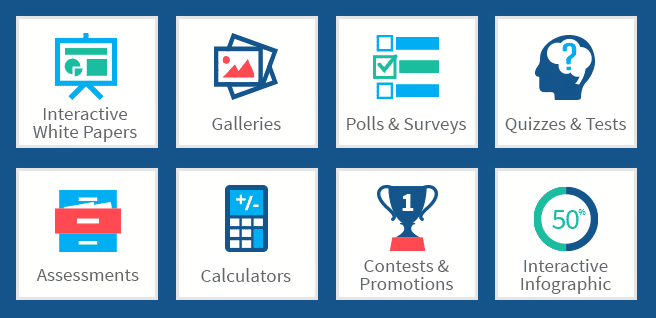
Delighted customers are great promoters, and they will likely share your interactive content. Don’t forget to include an embed code and social sharing buttons to make the job easier.
11. Give Away Useful Templates and Spreadsheets
Not everyone’s great at customizing spreadsheets, especially if they use formulas. So, if someone else does it and gives it away for free, it’s easy to see the value. Prospects will gladly opt-in in exchange for this highly useful template.
So from here on out, compile the templates and resources you use for your company, and transform them into downloadable offers to help your prospects simplify their processes and workflows.
12. Record the Actions of Your Website Visitors
An excellent way to diagnose why your website visitors aren’t converting is through analyzing their actions on your website. Tools like Hotjar or Mouseflow can allow you to record user sessions and plot heatmaps on most-clicked buttons on your site.
Many Conversion Rate Optimization (CRO) experts swear by this step and maintain that it’s one of the fastest ways you can uncover the “whys” in your process:
- Why are they not converting?
- Why are they not filling up my forms?
- Why do they like this webpage so much?
From here, you can rectify a situation or apply more of the same strategy to your other pages. This is helpful for A/B testing as well.
13. Optimize Your Website for Mobile
B2B online queries are noticeably shifting from personal computers to smartphones. Indeed, Google’s research confirms that 50% of B2B queries are made on mobile phones.
This number is expected to reach 70% by 2020 as we take into account the entry of more B2B employees from the “digital generation” (Millennials and Gen Z), and the increasing use of smartphones by older generations.
Additionally, a recent BGC report on B2B buyers’ usage reveals that 60% B2B buyers admit that mobile played a significant role in a recent purchase. Specifically, mobile can accelerate time to purchase by 20% by increasing efficiency in decision making and enhancing team collaboration. BGC further reports that 42% of the average share of total revenues are contributed and influenced by mobile.
The questions you need to be asking yourself are:
- Is AMP implemented on my website?
- Are all my web pages responsive? Do they pass the Google Mobile-Friendly test?
- Is the content of my website optimized for mobile-first indexing?
- Am I maximizing engagement with micro-interactions?
Optimizing your website for smartphones is not only beneficial to your B2B marketing goals but also help your buyers make business decisions efficiently. You need to factor mobile into an omnichannel customer journey and finding new and improved ways to reach and engage your audience.
14. Encourage Online Reviews
A study by RevLocal found that 92% of consumers read online reviews when considering a product or service.
If your website doesn’t have a testimonials page or a reviews feature, it could be hurting your chances to get contacted. Create opportunities for your clients and customers to add a review and post it on your website.
Reviews build consumer trust, improve your local search ranking, and ultimately improve conversions. The RevLocal study also found that consumers are likely to spend 31% more on businesses with stellar reviews.
15. Expand Your Online Presence
The persona of your brand is not limited to your website and social channels only.
Branch out and appear on other sites to grow your credibility, such as guest blogging, getting interviewed, or answering questions on Quora.com or other industry-specific Q&A sites or forums.
This is a great way to build authority for your personal brand and put your business name in front of those seeking relevant solutions to their problems.
Quora alone can help you gain thousands of leads if you answer the relevant questions in your industry. Developing your brand as a thought leader can increase brand awareness and also help first-time learners about your brand build trust faster.
16. Answer Questions on Quora
This question and answer platform is rapidly gaining popularity. In fact, Quora now has over 100 million active users.
Through the full-text search feature, you can look for questions that are relevant to your specific niche or interest. By consistently providing helpful and educational insight, you can get noticed by your target audiences who use the platform. This strategy is great for building brand awareness.
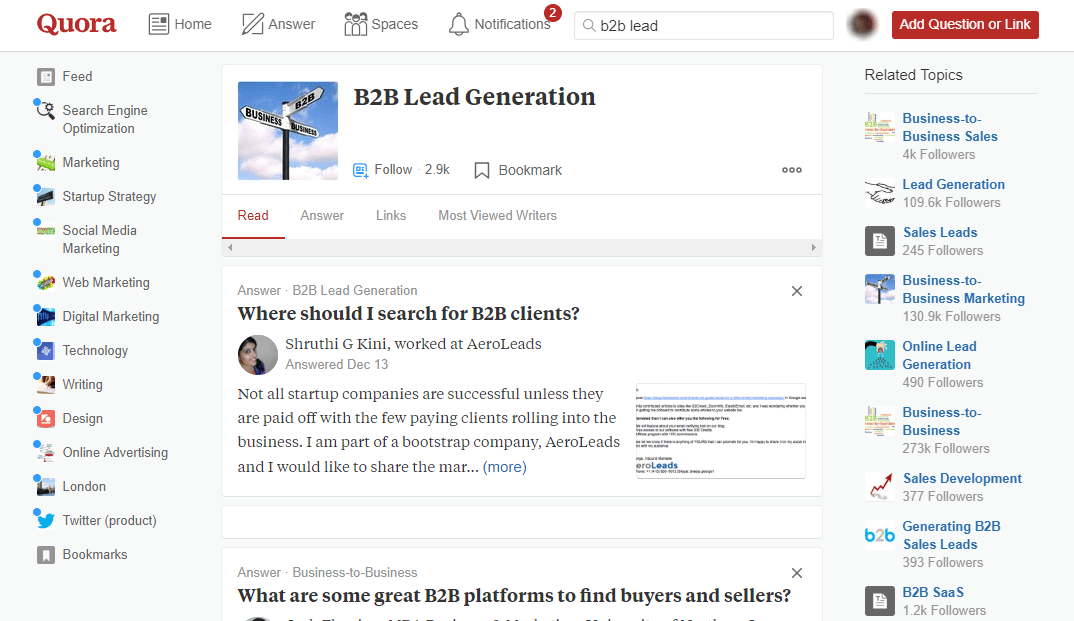
If you’ve created content that specifically addresses a question on Quora, then you can place a link to it in your answer. If the content is relevant enough and the question gets a significant amount of traffic, you can expect to see a few new visitors trickle in.
17. Use Gmail Ads to Target Your Competitors’ Audience
Email is still the most popular lead generation channel—77% of B2B marketers use email marketing to drive leads, according to SuperOffice’s State of B2B Email Marketing report.
In B2B, there is a lot of value at drawing the attention of your competition’s customers. Gmail ads allow you to target your Google Ads campaign to people who have received emails from your competitor. Sounds sneaky? It is, but it’s effective. It gives you direct access to people who are already familiar with the nature of your service.
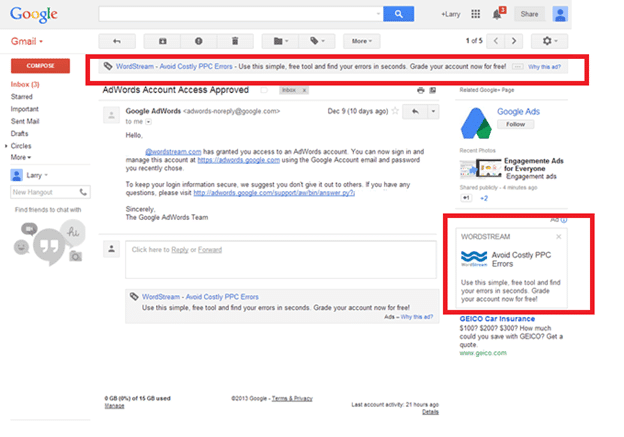
18. Ramp Up Your Video Marketing
Video marketing presents a promising opportunity to reach your target audience. More than 75% of Fortune 500 executives view video content regularly and around two-thirds of that number visit the vendor’s website, as per a Forbes study titled Video In The C-Suite. So, it’s safe to say that video is a highly-effective way to attract leads.
Indeed, video content has been known to be a major driver in purchasing behavior. Animoto’s State of Social Video study found that 64% of consumers make a purchase after watching branded social video content. What’s more, a video on a landing page can increase conversions by 80% or more, according to data from Adelie Studios.
HubSpot’s State of Inbound Report also found that 48% of marketers are already planning to include YouTube in their content strategy in the coming years. Don’t lag behind the competition. Get your camera rolling!
19. Automate Social Media Sharing
Give your digital footprint a boost by promoting your content on Facebook, Twitter, LinkedIn, and any other social platform used by your target market.
However, most marketers have too much on their plates to prioritize social networking. Thankfully, there are numerous tools and apps for automating social media or scheduling posts, shares, likes, tweets, and any other social engagement you can think of.
I use Hootsuite, but Sprout Social and Buffer are also highly recommended by marketers, as they not only automate sharing but also provide analytics to make sure that you’re sharing content optimally.
20. Attend Offline Events
It’s not enough to just be visible online. Your clients see you on the web, but do they physically see your brand anywhere else?
Attending offline events such as digital marketing conferences and trade shows can help you generate leads from other areas of interest.
Some businesses, especially the older and larger companies, do not rely on the web for networking with partners and customers. They like putting a face on the name, and they want someone they can trust.
21. Speak at Events in Your Industry
There are a wide variety of trade expos and conferences that you can join or attend. But becoming a contributor to these events will majorly amp up your credibility as an authority in your field. Not only that, but you’ll also have the undivided attention of a relevant audience, which is a huge opportunity to impress.
So the next time you get invited to speak at an event, say ‘yes’ as quickly as you can. It doesn’t hurt to volunteer for these events either.
22. Turn Up Your Retargeting
Prospects usually browse several websites and comb through dozens of articles to guide their purchase decisions. Only 2% of buyers make a purchase on the first visit. Retargeting aims to reel back the 98% and give them a nudge towards your brand.
Retargeting is still underutilized by B2B marketers, but it is catching on. About 70% of marketers allocate 10% or more of their budgets to retargeting. So, if you haven’t already, start retargeting your website visitors now and increase the chances that they choose your brand over your competitors by 70%.
You might consider putting up ads that show varieties of content (soft sell vs. hard sell). Prospects who aren’t ready to make a purchase might be convinced to buy if your brand is continually visible to them.
23. Maximize Marketing Automation
Marketing automation tools are the marriage of email marketing tools and CRM. Marketing automation software connects with your CRM to automatically send highly targeted and personalized marketing emails to leads. This tactic ensures that you put relevant and timely content in front of the right prospects.
Thomson Reuters testifies that their revenue increased by 172% when they adopted a marketing automation solution. Nearly a third of marketers attest that email is their most effective lead generation tactic. In itself, email marketing is already acing it, and it has been for quite some time.
Integrate the functionalities of CRM, and you’ll see why B2B marketers rank marketing automation as one of the best ways to generate better and more qualified leads.
24. Engage Prospects with AI Chatbots
Chatbots are artificially intelligent messaging-based bots that can autonomously engage your website visitors and automate business transactions. AI processes text or speech input by your prospect or customer and sends an appropriate response.
Adopting chatbots sends a strong message to your prospects such that you want them to have a seamless interaction. Additionally, integrating AI into your lead generation strategy creates new avenues for process efficiency and optimization. Minimizing your dependency on human customer support and lead generation will also inherently reduce operational costs.
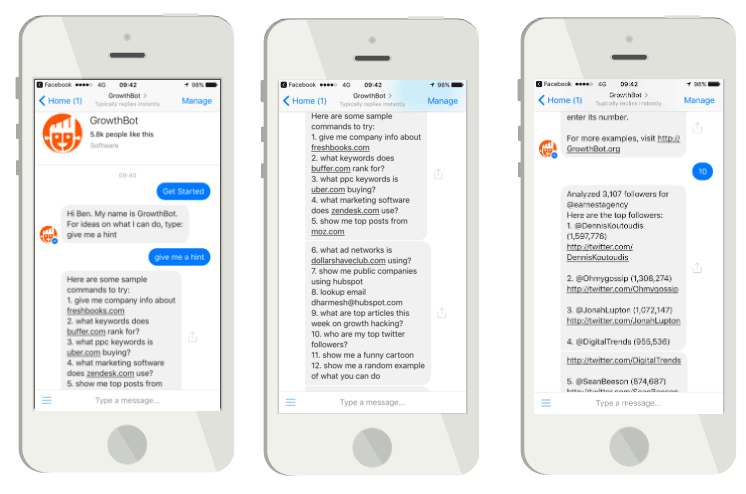
25. A/B Test Your Paid Campaigns
A/B testing with paid campaigns makes sure that you’re employing strategies and channeling money into what works. The beauty of A/B testing is its ability to quantify the value of each strategic tweak to your lead generation campaign, so you know exactly how well each experiment performs.
You don’t want to cast your net blindly, so keep testing new strategies and ideas to figure out which you need to stop, and more importantly, which you need to scale.
26. Harness the Power of Micro-Influencers
Influencer marketing is as strong as ever, but in 2018, we’re seeing a shift towards brands making use of lesser-known influencers (people with authority in smaller niches). These guys might have fewer followers, but their relative level of influence remains the same.
The industry is getting saturated, and major influencers are getting bombarded with requests. Not only does this make popular influencers very expensive, it also makes them extremely picky about who they work with.
The best solution to this is for brands to leverage micro-influencers. These micro-influencers are relatively untapped despite their huge potential for reaching new audiences effectively. What’s more, they tend to cost less and aren’t sick and tired of unsolicited approaches from other brands.
27. Analyze Your Data
Improve your market research, data gathering methods, and analytics to determine who your ideal audience is, where your prospects are coming from, which channel is generating the most leads, and which leads are more likely to convert into sales.
Data analytics can also help you determine behavioral changes in your buyer personas so you can adjust your drip strategies accordingly. Analyze constantly! Metrics and numbers don’t lie. Identify significant trends and learn from them.
At a minimum, you should be collecting data using Google Analytics, but if you’ve got the resources, it’s worth investing in a CRM tool that fits your specific needs.
28. Profile Your Target Audience
User behavior evolves just as quickly as innovations in technology. It’s important to study your target audience and create effective buyer personas to better understand users’ pain points, challenges, goals, and buying behavior.
If last year, you were able to provide their needs and wants, then maybe this year you can focus on another challenge they may be facing.
Think about something you can address with an innovative product or content offer. Remember that your buyer persona will shape your content marketing strategy and that this is where it all begins.
29. Work Closely with Your Sales Team
Your sales personnel are the ones who interact with your clients, so it’s important to get their qualitative feedback so you can combine it with your quantitative data.
You can also get a clearer picture of who your buyer persona is from your sales team.
Sales and marketing have always worked hand in hand to achieve the best results. Proper sales and marketing alignment usually results in higher conversion rates, better performance from both departments, and a more functional working environment altogether.
30. Stay on Top of Google
Is your website on the first page of Google? More than 90% of users don’t go beyond the first page of SERPs. This is why the first page is a much-coveted spot. SEO today is all about relevance and authority, and that’s how you should address your brand’s online assets.
Also keep in mind that ranking well isn’t just about the traffic. Getting your business on that first page also says a lot about your company, as it establishes you as an authority in your niche.
31. Quit Cold Calling
Cold calling is joining the ranks of 8-track tape players and Palm Pilots; it’s clunky, it’s outdated, and it’s ready to be put out to pasture. Ten years ago, reaching a prospect was possible after 3 or 4 cold calls. Now? That number of attempts has jumped up to 8. Is it any surprise that 44% of salespeople surveyed admit to calling it quits after the first unsuccessful follow-up call?
Prospects are used to self-service options and finding business partners via thought leadership or email campaigns, not unsolicited phone calls. In fact, these calls may actually hurt your chances as much as help them. Even cold calling’s champions report a conversion rate that hovers around 2%.
But cold calling’s fall from grace doesn’t mean your sales team is done for. There are far better ways to generate qualified leads and grow your business. (Just read the rest of this post.)
32. Ramp Up Your Inbound Marketing
And any good inbound marketing strategy relies, above all, on a combination of compelling content and intensive SEO.
Inbound strategies are also cost-effective. Inbound leads are 60% less expensive than outbound leads. Content series that draw your company’s target audiences in and keep them coming back to learn more are great conversion tools, especially when they involve strategic calls to action and landing pages to entice your readers to stay in touch and learn even more. Your content can take a variety of forms: guest articles, blog content, informative whitepapers — the list goes on.
An SEO strategy has gone from a nice-to-have to a must-have. It’s one of the best ways to ensure that your company is consistently found by the right audience. Whether you hire an in-house team to focus on boosting search rankings or outsource this effort, identify the keywords that make your business stand out.
Keywords aren’t the only way to implement SEO practices. You should also ensure that your URLs are formatted properly, your web pages have unique titles and meta descriptions, your pages load quickly on mobile devices, you earn links from authoritative publications in your niche, and so on.
33. Launch Incentive-Based Referral Programs
Don’t take word-of-mouth marketing for granted—it’s still the primary factor behind almost 50% of buying decisions. More stats show that B2B companies with referrals reportedly have 70% higher conversion rates and a similar faster close time on sales.
Your satisfied clients are the best people who can market your business to others. Incentivize referrals! Make it more exciting for them by creating customized referral codes that entitle them to discounts. This also makes it easier for you to track where your leads are coming from, and which are converting.
34. Integrate Your Marketing Campaigns
Experiment with different strategies. Unify and integrate your tactics across multiple lead generation channels.
A single voice that resonates shows your audience a solid brand personality. This is imperative in B2B lead generation to show users and businesses that your company is reliable and that your brand is here to stay.
Essential Questions You Need to Answer Before You Start Lead Generation
You’d think that most companies have figured out the best ways to collect prospect data. Unfortunately, you’d be wrong. In reality, designing the actual lead generation strategy is still a challenge, as 42% of 845 companies admitted having difficulty in planning a tactic for generating leads according to a survey by the Information Technology Services Marketing Association and Rain Group.
The good news is that plotting your strategy for lead generation is as easy as asking the what, who, where, when, and why of the sales and marketing processes. These questions should be set forth and answered carefully before planning a successful lead generation strategy. Your answers can be used not only as benchmarks for when you move forward, but also to avoid common mistakes, make better, informed decisions, and show where you need improvement in the planning, as well as with the process itself.
What do your potential customers want?
Assuming that you already know who your targets are (as you should, by now), the next thing to find out is their needs. Ask what their goals and pain points are to fully understand what value to deliver and how to tailor your message when communicating with them. This means doing industry research, surveying consumers, consolidating information, and trying to make sense of the data.
What can your business deliver?
Develop a unique selling proposition (USP) about your business and make sure that the entire organization aligns with and understands it. The USP informs your target market why they should buy or get your product or service and what makes you different compared to the competitors—what can you promise and deliver to potential customers and what is your value proposition? The message should be communicated right from the start of the buyer’s journey, as it will make your business stand out.
Who is your lead?
You cannot generate a lead without knowing your business’ definition of “lead.” Make sure that all the teams involved in the process (especially the Sales and Marketing departments) agree on who the company is trying to get. Aside from having a definite explanation of your target lead, this step can also help in Sales and Marketing alignment.
How do you reach your leads?
Find out which channels to use to communicate with your leads by learning which websites they usually go to, the frequency of visits, and how they search for information. Once answered, you can utilize strategies like content marketing, paid advertising, sponsorship, and affiliate programs targeted at your prospects. From this data, you can then set up surveys, social media monitoring, interviews with current customers, A/B testing, and a lot more to gather information on or drive your leads.
At what point in the sales process do you want to generate leads?
Every step of the sales process can generate leads, albeit not of the same quality. Therefore, the approach should differ at each point. For example, someone who’s in the early stages is still learning about their problem and will probably need more nurturing. However, the same technique will not work if the person is already ready to buy. Know the stages of your sales funnel inside out, and you’ll be able to zero-in on potential bottlenecks so that you can maximize conversion rates.
What do you do with the lead?
Leads should be directed to the Sales team for the final step (closing), but then, some of them may need to be directed to Marketing for nurturing, as they may not be ready to make the purchase yet. Lead nurturing is the process of directing leads along the funnel to prepare them for the last part of the buyer’s journey by informing them why they should buy from the business. It’s essential to come up with an effective nurturing process and stick with it.
When do leads become prospects?
To establish if a lead is ready for purchase, your company should first have a method for lead scoring. In lead scoring, a lead can either be a Marketing Qualified Lead (MQL) or a Sales Qualified Lead (SQL). An SQL is a lead for a person in the Sales team to reach out to, while an MLQ is one that is for Marketing, as further nurturing is needed. There are key indicators needed to determine the score of a lead. Metrics for these indicators can be set through a Service-Level-Agreement (SLA) between the teams.
Where are you going to distribute your content?
Any content that earns you a place in customers’ minds as a trustworthy source is worth creating. And you can choose to deliver this content via blog posts, videos, images, infographics, webinars, whitepapers, ebooks, and the like. Depending on the type of content you create you can learn which distribution channel should be used—websites, blogs, social media accounts, and email are all great options. You can even leverage gated or exclusive content to collect key information from your prospects in exchange for giving them access to your content.
What do you want customers to do after they purchase?
Interaction with a lead or customer shouldn’t end after the purchase. After all, satisfied customers can be utilized to gain even more leads and prospects, as they help you put lead generation strategies in the context of the customer journey. Customers can be beneficial in gaining good publicity, especially in this era of social media.
How will you track your progress?
Nowadays, there is no better way to track your lead generation progress than through CRM software. It’s reached the point where if you don’t have an effective customer management tool, you’re planning to fail. With the right CRM software, you can quickly and accurately track the status and success of leads based on the goals and metrics set. In addition to behavioral data, these tools can help store and manage contact data, which can help in your lead qualification process.
Set Up a Data-Driven Process for Lead Generation
“Measurement is the first step that leads to control and eventually to improvement. If you can’t measure something, you can’t understand it. If you can’t understand it, you can’t control it. If you can’t control it, you can’t improve it.”
– H. James Harrington
Among marketers, whether traditional or digital, data is king. Every marketing decision must be based on cold, hard data, and every initiative should be monitored to produce more data so that it can be leveraged in the future. In short, data-driven marketing is not a buzzword; it’s a necessity.
When analytics is applied to data, it can help companies make fact-based decisions, which can then dictate business strategy and influence growth. Being data-driven allows your organization to clearly define the purpose behind any business strategy and provide evidence for various tactics with factual evidence.
Data can come from just about anywhere – sales transactions, customer interactions, social listening, surveys, and consumer feedback are just some of the channels where you’ll find masses of useful data to collect and manage.
Leveraging data for any business decision involves planning, measuring, collating, analyzing, and interpreting business data to effectively understand what it means. It’s an ongoing process, and the foundation for continuous improvement so don’t think about it as being a one-off thing.
Here are the steps you can take to leverage data-driven marketing and generate quality leads…
Identify Success Metrics: Thanks to technology, marketers can now gather all sorts of data, and analytics can make sense of the numbers. However, among these figures, you need to identify which metrics you will use to measure the success of your campaigns. Is it the number of website visits? The numbers of inquiries made? Or is it the number of downloads? First of all, you have to identify what needs to be measured and how you will go about it. The key is to be thorough.
Make a Plan: The metrics you identify should be aligned with campaign goals and strategies. “Give the data and numbers a meaning outside of their numerical value. This is done by first knowing what your goals are and the KPIs that will have an impact on those goals,” said Erik Bitmanis from Iversoft Solutions. It’s not enough that you measure how many responses a particular campaign receives in a day. You have to know where and who these responses are coming from, as well as from which channel. Ensuring that the right information is collected will make your data more valuable.
Do a Test Campaign: The key is to test the waters before going in for a dive. A shorter pilot campaign will help marketing teams decide if the existing data-gathering plan will work well in the field once the campaign is launched. This will also give your team time to make necessary tweaks.
Review the Results: Data provides insights to help determine if a campaign is hitting the right metrics and reaching set goals. It’s important to analyze not just the results of the test pilots, but also the results of “actual” data-driven tasks for every campaign released. Analyze the results and share the data with marketing teams, as well as relevant stakeholders to give them a clearer picture of what is working and what’s lacking. The data gathered will also provide a business case for any investments that need to be made.
Set Up Best Practices: As you move forward, you can set up best practices by looking at what works best for which channel and campaign. Regular activity evaluation will also determine which ones need to be upgraded to accommodate more volume or address a new requirement. The goal is to repeat the tactics that work and tweak/remove the ones that don’t. Soon enough, you’ll have yourself a collection of effective data management processes that keep your business in the “know.”
Level Up: Data can help management teams make investments not only in data-gathering activities but also in marketing initiatives. Marketers should adopt a strategy that will allow them to repeatedly test and learn. This will raise their standards in terms of determining true ROI over time.
Marry Data with Creativity: Some experts say that marketing teams often need structure, not creativity. However, creativity is something you can use to develop or maintain such structure. There are also those who say that data-driven marketing is a bad idea, as it impedes creativity. Many still wonder if structure and creativity co-exist in the marketing world. The goal is to find the right balance between the two. Marketing teams should provide room for creativity in their data-driven lead generation campaigns. Outside-the-box thinking can often lead to breakthroughs that may result in achieving new heights. The key is to keep testing to find the right strategies that work and to keep moving forward.
Keep Testing: Becoming a data-driven organization can’t be achieved in a day. It takes time as well as constant testing and improvement. Taking a scientific approach to data-driven marketing is a good place to start, but eventually, you need to fuse analytical thinking with a bit of ingenuity to come up with more ways to make this type of marketing work for your campaigns and initiatives.
Raring to Generate More Leads?
A growing business means a profitable business. However, profitability is only possible when the right customers purchase your products and services. It’s far from impossible, but acquiring both clients and prospects is a process that needs to be taken seriously.
Nailing your lead generation strategies is the foundation of all your other moves along the sales cycle. Be smart and creative in getting your visitors to engage and convert.
These creative strategies will help your brand stand out from the noise when used in conjunction with your current marketing and lead generation strategies. Remember that creating helpful, useful, and educational content is key to delighting your prospects and gaining their trust.
So the next time you’re looking for more leads, give these creative tactics a try. You might just find a new favorite channel for your brand that produces high-quality leads.
If you are ready to get more traffic and leads from your website, you need quality content that’s published consistently. So check out our Content Builder Service. Set up a quick consultation, and I’ll send you a free PDF version of my books. Get started today–and generate more traffic and leads for your business.







Great list, Anna. You covered a lot of things here, the Gmail ad targeting is an interesting tactic. I wonder how successful it is? Encouraging online reviews is important, but so it responding to them. It looks like the new marketing funnel is expanding, which also gives more opportunities.
Thanks for your comment Richard. Great question on Gmail ad targeting. I did a quick search and found this: https://searchengineland.com/a-quick-and-dirty-guide-to-winning-with-gmail-ads-310461
Hopefully that helps!